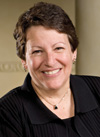
Dec. 21, 2016 – George Brown, in his November 2016 Wisconsin Lawyer Executive Director column, stated that “Gary Bakke was Right.” In 2000, then State Bar President Gary Bakke declared that the “status quo is not an option.” He proposed that the State Bar of Wisconsin “seize the future” by approving changes similar to those being considered to the American Bar Association Model Rules of Professional Conduct, which would allow lawyers to practice in multidisciplinary practices.
Gary’s Seize the Future program looked at the challenges confronting the legal profession in 2000 -- rapidly changing technology, demographic changes, and an increased focus on alternate dispute resolution and self-representation. Note that in 2000, the Great Recession and its consequences to the legal profession were not yet on the radar.
 Diane Diel (Wisconsin 1976) of Diane S. Diel S.C. practices family law in Milwaukee. She is a past president of the State Bar of Wisconsin, past chair of the Wisconsin Collaborative Family Law Council, and past president of the International Academy of Collaborative Professionals.
Diane Diel (Wisconsin 1976) of Diane S. Diel S.C. practices family law in Milwaukee. She is a past president of the State Bar of Wisconsin, past chair of the Wisconsin Collaborative Family Law Council, and past president of the International Academy of Collaborative Professionals.
At that time, Gary A. Munneke, a law professor and futurist, predicted that lawyers who “provide high-end, value-added services” had a bright future. He also observed that more and more people would turn to alternative dispute resolution processes and to self-representation because people “view lawyers as obstacles to conciliatory outcomes.”1 The Board of Governors developed a series of resolutions, conducted town hall-type meetings and studied the concept of Multidisciplinary Practice or MDP until November 2002.
Collaborative Divorce, the out-of-court interdisciplinary settlement process, was also introduced in Wisconsin in 2000. The notion of practicing in a firm with the psychologists and accountants who were working in the development of Collaborative Divorce practice was galvanizing to some. To most lawyers then on the Board of Governors, MDPs were thought to threaten the core values of lawyering, compromising confidentiality if other professionals owned an interest in a law firm.
We know what happened to the MDP resolution.2 Ultimately, only a few governors supported the idea of practicing in interdisciplinary firms. The resolution supporting MDP was crushed.
Crushing MDPs did not, however, slow the development of interdisciplinary work for family lawyers. Today, psychologists, social workers, accountants, and financial planners are actively and appropriately involved at nearly every phase of an active divorce case, both in collaborative cases and in every other kind of divorce process.
Wisconsin’s Collaborative Family Law Council continues its work and its interdisciplinary practice growth. With the recent changes to Wis. Stat. section 802.045, allowing a lawyer to appear on a limited-scope basis and then provide a notice of termination of limited appearance (section 802.045(4)), Collaborative Practice is available in all Wisconsin counties. Key to the success of Collaborative Practice is the interdisciplinary teamwork. The more important story is that interdisciplinary work has taken off in all divorce processes.
In litigation, lawyers have taken some of the teamwork of Collaborative Practice into traditional litigation cases. The capable work of mental health professionals as child specialists, and as single or dual mediators (one mental health professional mediator per client), is called on to resolve many contested placement and custody cases. Milwaukee County judges increasingly refer cases early in the litigation process not just to retired judges for mediation but to mental health professionals when the issues are child-focused or to lawyer-mediators who work in tandem with such professionals. The same occurs with interdisciplinary tandem work with financial professionals when tax, retirement, or financial projection expertise is needed.
In some litigation cases, lawyers are using a parallel to the collaborative model by engaging mental health professionals to gain information about the family and the children in the role of child specialist and then providing feedback and assistance to the parties in developing parenting plans. Such professionals are typically protected by a Stipulation and Order or by the designation of family mediation under section 904.085.
In cases that start in the mediation process, lawyer-mediators and/or mediation services increasingly use interdisciplinary teams to provide financial education, explore settlement options, and help parents establish child-centered custody and placement plans. One Milwaukee mediation service mandates a family specialist approach for families with children.
Lawyers working with interdisciplinary teams successfully resolve challenging placement and custody cases. They are the lawyers who, today, provide high-end, value-added services to divorcing families. And, they are doing it with professionals from disciplines whose training is specifically targeted to the problems and issues clients are facing. Regardless of the entry door, this is a positive outcome for families, lawyers, and the courts.
Endnotes
1 74 Wisconsin Lawyer 3, “Setting a Course for the Future,” by Ann Massie Nelson.
2 See, The Findings, p. 17, #6, of the ABA “A Report of the Future of Legal Services in the United States, “The Legal Profession’s Resistance to Change hinders Additional Innovations.”
